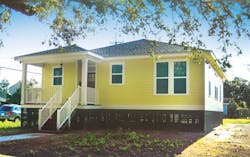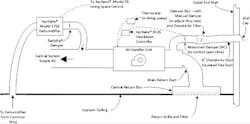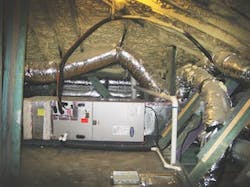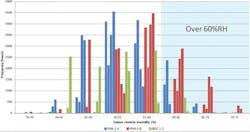New high-performance homes built using airtight construction practices and with improvements in insulation greatly reduce heating and cooling loads. However, in humid climates, reducing the cooling operation also reduces humidity removal, thereby increasing a home’s humidity levels. This is especially true during longer shoulder seasons (spring and fall) when there is less demand for heating and cooling.
Understanding how to manage indoor humidity in low heating- and cooling-load homes in humid climates is critical to promoting long-term occupant comfort, indoor air quality, and building durability. To address this issue, the Energy Department’s Building America program is currently developing best practices for optimizing comfort in low-load high-performance homes.
Building Science Corp. (BSC), one of the Building America teams, recommends installing a separate dehumidifier to reduce risk in controlling humidity levels. This finding is based on a study of new homes in a hot, humid climate released by BSC in November 2014.
Four of the homes in the study were equipped with a supplemental dehumidifier that pulls air from the home, dehumidifies it, and adds it to the air stream on the supply side of the heat pump’s air handler to be distributed, along with the cooled air, throughout the home.
The study was designed to evaluate performance with and without supplemental dehumidification systems. Ten homes with similar floor plans and energy-related characteristics (four with ducted dehumidifiers, two with standalone dehumidifiers, and four with no dehumidifier) were outfitted with a monitoring system to measure heating, ventilation, and air conditioning system conditions and the energy use of major appliances. The intent was to compare the performance of two house types and observe any trends on interior humidity control.
In this project, BSC sought to address the following research questions:
• Are indoor humidity levels elevated—and to what extent—in homes without supplemental dehumidification compared with homes that have supplemental dehumidification?
Heat pumps and supplemental dehumidifiers were installed in the spray-foam insulated and air-sealed attic.
• How much variability in interior relative humidity (RH) is observed from house to house? Is variability correlated with hot water use, clothes dryer operation, or cooking activities? Are there any other explanations for variation in RH?
• How much supplemental dehumidification is needed to control indoor RH to about 55 percent, but less than 60 percent, in these homes throughout the year?
• What metric is most appropriate for evaluating the extent of humidity problems and the success of supplemental humidity control?
This study is only one of a number of coordinated projects seeking to develop solutions for the residential industry. Read the full research study here. For more information on other related projects, visit the Building America website.
In the study of 10 homes, the two homes with stand-alone dehumidifiers (BDC 1 and 2) seemed to perform better than the four homes with supplemental humidifiers integrated into the central air handler (PHA 1-4), and both of these groups kept relative humidity under 60 percent for more hours of the study than did the control group, which had no supplemental dehumidification. However, variabilities in occupant behavior between the homes may have affected results.
Building America Solution Center—World-Class Research at Your Fingertips
Visit the Building America Solution Center to learn how this unique tool provides building professionals with proven efficiency innovations and best practices from Energy Department–approved building science research for hundreds of high-performance home technologies. The Solution Center brings together recommendations from the country’s top building science experts, who work directly with the housing industry, to help participating builders and remodelers continuously improve their construction practices and strive toward zero energy-ready homes.



